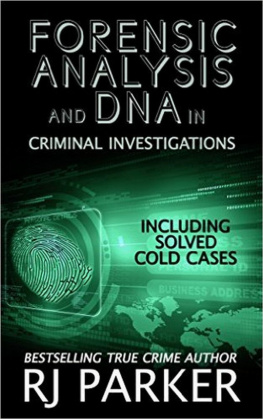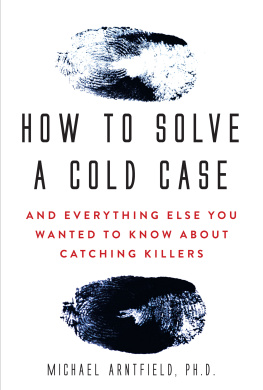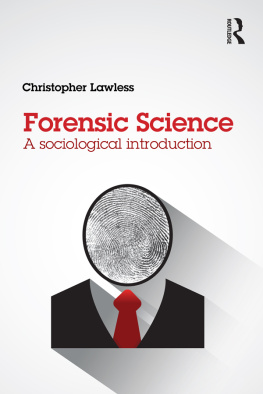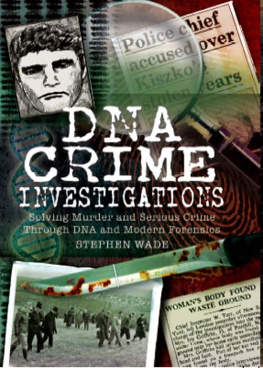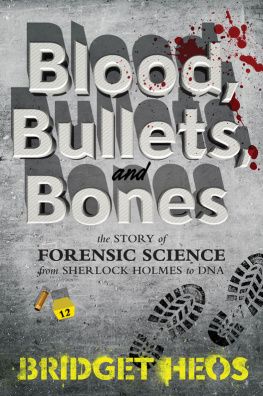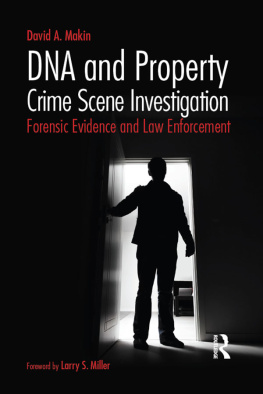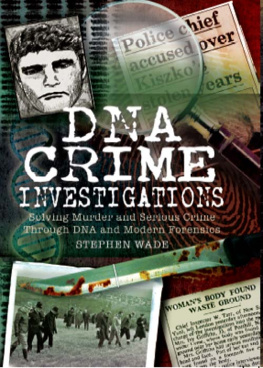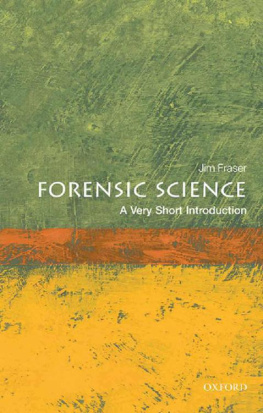ForensicAnalysis and DNA in Criminal Investigations: Including Cold CasesSolved
by RJParker
and PeterVronsky (Preface)
Copyrights and Published by
RJ ParkerPublishing and Smashwords
http://m.RJPARKERPUBLISHING.com
Copyright
This book is licensed for your personal enjoyment only. Thisbook may not be re-sold or given away to other people. If you wouldlike to share this book with another person, please purchase anadditional copy for each recipient. If you are reading this bookand did not purchase it, or it was not purchased for your use only,then please return to the author and purchase your own copy. Thankyou for respecting the hard work of the author. All rightsreserved. No part of this publication can be reproduced ortransmitted in any form or by any means without prior writtenauthorization from RJ Parker Publishing andSmashwords. The unauthorized reproductionor distribution of a copyrighted work is illegal. Criminalcopyright infringement, including infringement without monetarygain, is investigated by the FBI and is punishable by fines andfederal imprisonment.
Preface:
The Pioneering Days, a Brief History
By PeterVronsky
Humanoids have been around for a million yearsour species ofhomo-sapiens for about a hundred thousandwe came out of the caveand bush and became civilized about fifteen thousand years ago,and until about only two hundred years ago, we were a very chaoticand disorganized species, so disorganized that there did not evenexist such a thing as a police department, let alone forensicscience. Order was kept by standing military forces, who mainlywere concerned with keeping the Kings peace, thus the Europeanterm gendarme ormen at arms. In the English-speaking world, the term constablehad its origins in an ancient Byzantine era term: comes stabuli , meaningmaster of the stable. English Kings commanders of mounted knightenforcers came to be known as constables until the term wasmodernized and bureaucratized in the modern age. The term policemeant to implement policy and there was no such thing as amunicipal police department in the English-speaking world until thefounding of the London Metropolitan Police in 1829, which onlyrelatively recently ushered into the world our modern concept of apolice department as we now know it. And even then, for the firstfifty years police mostly prevented crime by patrolling on thebeat and ensuring people and property were secure. They did not domuch investigating once a crime was perpetrated and the reason whyis simple: forensic sciences and investigative techniques had notyet caught up to the nineteenth-century scientific world in whichthe seeds of modern policing and law enforcement were being firstplanted. Policing was emerging in a rapidly changing age ofsciences and the merging of the two was spectacular when it beganto unfold.
Since Dr. EdmondLocard (13 December 1877 4 May 1966), a pioneer in forensicscience who became known as the Sherlock Holmes of France, firstformulated the basic principle of forensic science: Every contactleaves a trace, also known as Locards Exchange Principle. Whilepolice authorities struggled to bring the sciences into criminalinvestigations, Locard argued that the perpetrator of a crime willbring something into the crime scene and leave with something fromit, and that both can be used as forensic evidence. Hestated:
Wherever hesteps, whatever he touches, whatever he leaves, even unconsciously,will serve as a silent witness against him. Not only hisfingerprints or his footprints, but his hair, the fibers from hisclothes, the glass he breaks, the tool mark he leaves, the paint hescratches, the blood or semen he deposits or collects. All of theseand more, bear mute witness against him. This is evidence that doesnot forget. It is not confused by the excitement of the moment. Itis not absent because human witnesses are. It is factual evidence.Physical evidence cannot be wrong, it cannot perjure itself, itcannot be wholly absent. Only human failure to find it, study andunderstand it, can diminish its value.
One of the firstfields to attempt to define a systematic scientific approach toforensic investigative techniques was that of physicalidentification experts, who gathered in 1885, in Rome, at the firstInternational Congress for Criminal Anthropology. According to anobserver from the Smithsonian Institution, the conference opened anew epoch in the history of crime It was proposed to investigatecrime scientifically, biologically, fundamentally; to investigateits origins, its causes.
Ledby Italian criminologist Ceasare Lombroso in a post-Darwinian ageof natural selection and genetic predisposition, the criminalanthropologists believed that criminals could be identified before they committed acrime (like in the futuristic Tom Cruise movie Minority Report ) because they weregenetically and physically predisposed to be criminals. In otherwords, people were born criminal, according to this school ofcriminology, and therefore criminals had certain distinguishingphysical characteristics by which they could be identified ascriminally predisposed even before they committed their firstcrime. But it was in the end proven to be quack science and camecrashing down a decade later when social and environmental factorswere identified by the broader forensic sciences community as theleading causes of criminal behavior, not genetic predispositionalone.
Gradually forensic sciences began to develop simultaneouslyin several different fields: the identification of the criminaloffender; the identification of the victim; the identification ofthe means and time of death; the discovery of evidence invisible tothe human eye, the ability to collect and preserve it andsystematically catalogue and classify that evidence fromfingerprints and barrel grooves on a bullet to blood types and DNAtrace evidence today. The complexity and breadth of differentforensic sciences as they developed over the last 150 years isbreathtaking, as were the various rise and falls of what wasthought to be various forensic sciences that were exposed as not asscientific as first thought, as for example, Lombrosos theory ofthe physically identifiable criminal type. But even so,Lombrosos focus on the physical characteristics of criminals ledto Frances Alphonse Bertillon to introduce a system of identificationbased on a series of physical characteristics that would bemeasured and carefully entered into a criminals file. It wasthought that no two people could have a similar combination ofcharacteristics. The process became known as the Bertillonanthropometric identification system, and it even includedfingerprints, but as in modern police work, the flaw was often notin the system but in the way the data was stored and retrieved.Police departments did not file records by fingerprint type but byBertillon measurement instead. The entire system came crashing downin 1911 when a workman in the Louvre stole the Mona Lisa. The French police had his fingerprints onfile but their records were filed by Bertillon measurements and notfingerprint pattern. Had the police used fingerprint data in thefiling system they would have been able to quickly identify theperpetrator but instead it took them years. By the first decade ofthe twentieth century, police departments around the world quicklylearned that while Bertillon records might help identify somebodyalready suspected, fingerprints unlike Bertillon measurements couldbe lifted at a crime scene and lead police to an unidentifiedperpetrator if their records are filed by fingerprint. By the 1910smost police departments began to abandon the Bertillon system infavour of the fingerprint classification system.
One of the earliest and most urgentdevelopment of forensic sciences was toxicologythe detection ofpoisons. While science was constantly introducing new potentiallylethal substances if administrated in massive doses that wouldmimic natural forms of deathmorphine (1803); strychnine (1818);brucine (1819; quinine (1820); conium (derived from hemlock; 1826);pure nicotine (1828); chloroform (1831); codeine (1832); andaconite and belladonna (extracted from deadly nightshade;1833)there were no chemical tests developed for any of these newpotentially deadly substances. The most used poison for murder inthat epoch was arsenic, a common ingredient not only in rat poisonbut in beauty products as well, reputed to cure pimples andblemishes. It was cheap, at ten pennies an ounce in the 1840s andit was colorless, odorless, and soluble in hot water. Two to fourgrainsa fraction of a teaspoonwas lethal (there are 437.5 grainsto an ounce.) The challenge facingforensic experts in arsenic murder cases was not a test to detectarsenic, but a test that would dramatically demonstrate to juriesthe presence of arsenic. A so-called Scheele test invented back inthe eighteenth century revealed the presence of arsenic byreleasing a garlic-like smell. But how does one produce a smellbefore a jury? Juries in those days by their nature were suspiciousof scientific experts in an age when one science after anotherwas being debunked. It was only in 1840 that British chemist JamesMarsh devised a test that produced a visible indication of arsenicthat could be brought persuasively before a jury, where jurorscould see it with their own eyes. The so-called Marsh arsenic testbecame the definitive tool in forensic toxicology to combat anepidemic of arsenic poisoning in mid-nineteenth centuryEurope.
Next page
